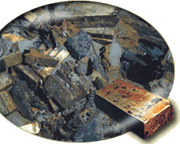

 |
 |

|
While Thomas G.
(Tommy) After extensive research into vessels lost in deep water, Thompson decided to focus on finding the SS Central America. The sinking was well documented by survivors' reports that could be analyzed for clues to the ship's location. The side-wheeler was far enough off the coast to be in deep water, which meant that technology, not luck, would play the most important role in finding and recovering it. The Central America was deep enough to remain undisturbed by storms, tides, and other natural phenomena that can disperse a shipwreck over many miles of ocean floor.
In 1983, he enlisted the help of Bob Evans, a longtime associate, who was a consulting geologist for the state of Ohio. Evans and Thompson compiled extensive passenger and crew information into what they termed a "data correlation matrix." On a 12-by-12-foot sheet of paper they entered every comment, every observation, every fact that might offer some insight as to where the ship might have been when it disappeared beneath the waves.
In the summer of 1986, the group Thompson had assembled, known as the Columbus-America Discovery Group, chartered an old Louisiana mud boat for a 40-day sonar search through the target areas. The weather window, or optimum period of good weather and calm seas, runs roughly from June to early October. Winter is a time for analyzing, planning, and retooling. Thompson used the season for developing the technology that had been his vision for years—Nemo, an undersea robot specially designed for historic shipwreck excavation using archaeological techniques, known in ocean-engineering circles as a remotely operated vehicle (ROV). If Nemo functioned as envisioned, it would be capable of extended, heavy-duty, and complex work in the deep ocean's harsh environment, and would thus establish mankind's first "working presence" more than a mile-and-a-half down.
During the winter of 1987-1988, Columbus-America purchased an old Canadian icebreaker, the Arctic Discoverer, which was retrofitted for the final search and recovery. Without definitive proof that they had found the Central America the previous summer, Bob Evans spent a good part of the winter reanalyzing some of the other targets the 1986 sonar survey had turned up. His analysis led the team to become intrigued by an anomaly at another site.
On Sunday, September 11, they lowered Nemo over the side and into the water to begin its descent to the bottom. A few hours after the underwater robot reached the bottom, five of the team members sat in the control room deep inside the hull of the Arctic Discoverer, staring at the images of the soundless seascape projected through the blue half-light of 12 video monitors. Suddenly, Milt Butterworth, the photographer-videographer, broke the silence. "Whoa… whoa… WHOA!!" The empty screen began to fill with dark shadows. Slowly a definable image took shape, drifting eerily up from the bottom of the video screens. As Nemo's cameras slid over the site, an unbelievable image scrolled by on the monitors: a rusting side-wheel lying flat in the eons-old mud. It was the one exceptionally distinguishing feature of the Central America. National TreasureIn a democracy like the United States’, there is no king, pharaoh, or czar, and hence no crowns, royal jewels, or pharaoh’s tombs. Accumulated treasures that do exist in America are either public or private, including great collections of art or other important cultural relics. On rare occasions, a significant treasure may be accumulated accidentally, the result of an act of nature or God. The sinking of the SS Central
America created just such an accidental accumulation of
treasure. Bound for New York with tons of gold
ingots, While many historical objects, accessories, ship components, and other items recovered from the SS Central America are being preserved for study by institutions and others, there were enough coins that this became a national treasure that could be shared. Thus, coins of a quality that had rarely been seen before, and would have been unavailable generally at any cost, are being offered to an enthusiastic worldwide audience of museums, historians, and collectors. Special presentations of selected examples have been made to the American Numismatic Association, the California Historical Society, and other museums. If you've been intrigued by the story of the SS Central America and her discovery and excavation, follow this link to sources for more details and how to acquire a piece of this fantastic treasure.
|
||||||||